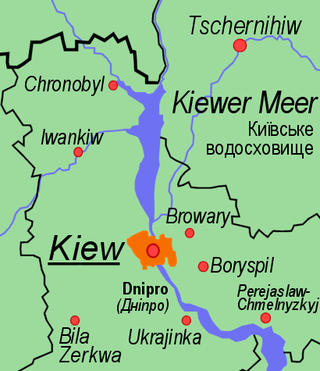Top Qs
Timeline
Chat
Perspective
Dnieper reservoir cascade
Flood control system in Ukraine From Wikipedia, the free encyclopedia
Remove ads
The Dnieper reservoir cascade or Dnieper cascade of hydroelectric power stations (HPP) (Ukrainian: Дніпровський каскад гідроелектростанцій (ГЕС)) is a series of dams, reservoirs and hydroelectric power stations on the Dnieper river in Ukraine. It was created to prevent uncontrolled flooding[1] and improve water transportation infrastructure. Coordination and operation of all dams on the Dnieper is conducted by government company Ukrhydroenergo.[2] In 1970, the Kyiv dam partially prevented flooding in comparison with the 1931 Kyiv flooding.[3]
Parts of this article (those related to 2022 Russian invasion of Ukraine) need to be updated. (October 2022) |

As with any dam, the water reservoirs of the Dnieper in Ukraine pose a significant threat of a large-scale, human-made disaster if their dams fail. Those concerns were raised in particular in connection with the 2009 Sayano–Shushenskaya Dam disaster.[4] Concerns had yet again been raised regarding an air attack of the Kakhovka Dam on 11 July 2022. The Kakhovka Dam would later fail in the result of an explosion that occurred on 6 June 2023.[5] Flooding will impact downstream communities such as Kherson and will have devastating consequences to communities on the bank of the Dnipro River south of Nova Kakhovka.[6]
To combat uncontrolled flooding, the National Academy of Sciences of Ukraine had developed a program of flooding forecasting; however, as of 2012, the Government of Ukraine refused to adopt it.[7]
Remove ads
Infrastructure
Power stations and dams
From source to mouth:
Water reservoirs
From source to mouth:
Remove ads
Concerns
Summarize
Perspective

Like other reservoirs, Dnieper reservoirs pose a potential threat of causing major flooding if their dams fail. Such damage may be inflicted by a powerful natural disaster (e.g., an earthquake), a human-made disaster, or a deliberate attack by terrorists or enemy forces at war.
The Dnieper reservoirs contain an additional major threat—after the Chernobyl Nuclear Disaster in 1986, radionuclides washed away by rains badly contaminated the bottom silt of the Kyiv Reservoir and presumably the others. During the years following the disaster, there were suggestions to drain the Kyiv Reservoir because it was too shallow.[citation needed]
The dams are supposed to be strong enough to survive natural and terrorist threats. Both their construction schemes and government efforts work towards this goal. For instance, some engineers guarantee that every Dnieper dam will survive an earthquake (to its typical regional extent), meteorite or aircraft falling.[8] There are also countermeasures against overflooding and malfunction of dams. Authorities pay significant attention to safeguarding the dams and bridges by special units of the Ministry of Internal Affairs and other security agencies.[9]
A failure of the Kyiv Reservoir would cause a flooding of the low-lying areas of Kyiv, mainly densely populated residential neighborhoods.[10] The aftermath of a possible complex flooding also include the spread of radioactive material from the Chernobyl disaster contained in the reservoirs,[citation needed] the widespread contamination by industrial and urban wastes and creation of swamps on bottoms of emptied reservoirs. The spread of radioactive silt could reach the Black Sea and endanger wildlife and humans dependent on the produce from the sea.
In 2001–03 the Security Service of Ukraine organized exercises on the Kyiv Hydroelectric station, simulating a possible terrorist attack. The results of the exercises were considered satisfactory.[10]
Government position
New concerns arose in 2005 after a fake terrorist threat case. A police officer, dissatisfied with his commanders, anonymously called an emergency line stating that he had planted a bomb in a cargo train crossing the Kyiv Reservoir's dam. An immediate check proved the threat to be fake and the officer was arrested. Regardless, the incident caused another wave of public concern.[11]
In 2012, the former Kyiv Hydroelectric Power Plant manager and veteran stated that the dam is guaranteed to be capable of withstanding any physical threat except for a large space object impact or a deliberate military attack of significant scale. However, an emergency plan exists to safely minimize consequences of a space impact depending on if there would be early warning of the impact event.[12]
Remove ads
See also
References
Further reading
External links
Wikiwand - on
Seamless Wikipedia browsing. On steroids.
Remove ads
